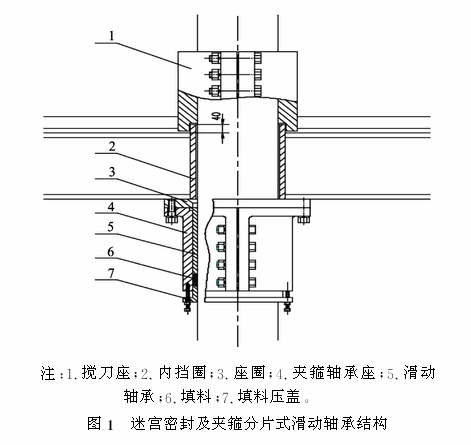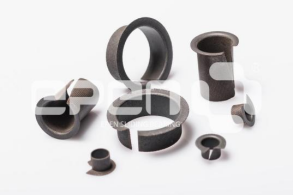Abstract: A maze structure is designed between the stirring blade seat of the bottom cold air layer of the desolver and the inner retaining ring on the cylinder bottom to seal the meal powder that leaks due to the rolling of the stirring blade and gravity. The sliding bearing and steel sleeve have been designed as a clamp split structure, making it convenient and fast to adjust and replace the sliding bearing of the dissolution machine.
Keywords: Desolver; Sealing structure; Clamp structure; sliding bearing
DTDC is currently the most widely used and superior equipment in oil and fat enterprises. The design and application of desolventizers are directly related to the product operation and economic feasibility of enterprises. According to different application characteristics, it is divided into 5 design intervals, namely: pre desolvation layer, countercurrent layer, desolvation layer, hot air layer, and cold air layer. The pre detachment layer, countercurrent layer, and cold air layer equipment are designed as two or more layers. According to the different leaching materials, the countercurrent layer and hot air layer will have different improved structural designs to meet the design conditions of material agglomeration characteristics, color control, moisture control, etc. The stirring power of the materials in the dissolving machine comes from the transmission system from the bottom reducer to the main shaft of the dissolving machine. The axial seal between the bottom of the bottom cold air layer cylinder and the main shaft is the key to the design of the sealing structure of the desolver machine, and its transmission structure is the main factor affecting the transmission efficiency and the convenience of operation and replacement. Based on practical engineering experience, the design structure of the bottom seal and segmented sliding bearing of the desolver has been updated.
1 Design of Bottom Sealing Structure for Desolving Machine
1.1 Common problems with the bottom sealing structure of the desalination machine
The DTDC commonly adopts a lower transmission structure to prevent the leakage of meal particles at the outlet of the shaft. Filler seals are installed to block the leakage. During the process of wet meal dissolution, drying, and cooling from top to bottom, multiple layers of stirring have formed a large amount of powder. Finally, under the rolling of the stirring knife and the gravity of the material layer, the meal particles slowly seep into the packing box from the gap of the sliding bearing. The seeping meal particles will exacerbate the wear of the packing, After the filler is lost to a certain extent, the residue will leak out of the filler box. At the same time, due to the sealing of the filler, the residue that seeps into the sliding bearing cannot be discharged, which will exacerbate the wear of the sliding bearing. As the equipment runs for longer, the wear gap of the sliding bearing will increase, and the leakage of the residue will become more serious. To prevent the leakage of the residue, it is necessary to continuously add filler and press it tightly. If not cleaned in a timely manner, the leaked residue will accumulate on the gearbox, posing hidden dangers to workshop health and safety production.
1.2 Design of the Bottom Labyrinth Sealing Structure of the Dissolution Machine
In order to prevent excessive leakage of meal residue, a maze like structure (Figure 1) was designed between the bottom stirring blade seat and the inner ring on the cylinder bottom. The inner ring that was originally designed to be flush with the upper plane of the cylinder bottom was extended up by 40mm, and a space was machined at the lower edge of the stirring blade seat to accommodate the extended part of the inner ring, forming a simple labyrinth sealing structure. The final layer of DTDC is a cold air cooling layer, which does not require sealing with liquids or combustible gases. This labyrinth structure can seal most of the meal that leaks due to the rolling of the stirring knife and the action of gravity. A filling structure is designed at the lower end of the sliding bearing seat, and PTFE woven packing with self-lubricating performance is pressed in to prevent the small amount of meal that crosses the labyrinth structure from seeping out.
1. Mixing blade holder; 2. Inner retaining ring; 3. Seat ring; 4. Clamp bearing seat: 5. Sliding Bearings; 6. Filler; 7. Packing gland
Figure 1 Structure of Labyrinth Seal and Clamp Piece Sliding Bearing
1.3 Design and Application of Bottom Labyrinth Sealing Structure for Dissolution Machine
This labyrinth sealing structure is installed in DTDC 240 × 6 peanut cake dissolving machine and DTDC 320 × During the use of the 7 cottonseed leaching and dissolving machine, even without the use of PTFE filler for sealing, there is basically no residue leakage from the clearance between the sliding bearings. Due to a significant reduction in the amount of debris that seeps into the clearance of the sliding bearing, the wear of the sliding bearing is also reduced, extending the service life of the bottom sliding bearing.
2 Design and Application of Desolvent Split Sliding Bearings
2.1 Transmission Structure Problems and Causes of the Cylinder Bottom and Spindle of the Dissolution Machine
The main shaft of the DTDC dissolution machine is supported by multiple sliding bearings fixed on the cylinder bottom. Traditional sliding bearings are designed to press the processed sliding bearings into a steel sleeve, string them into the main shaft for adjustment, and weld them to the cylinder bottom. Due to the deformation caused by welding stress, it is difficult to control, and it is difficult to adjust the sliding bearings after welding, which can cause heavy load on the idle motor, equipment resonance, and abnormal noise Abnormal wear and tear of sliding bearings. Although sliding bearings are made of highly wear-resistant copper alloys, wear is inevitable when operating in solid materials. After a certain period of operation, the desolver needs to replace the sliding bearings to improve its operational performance. Due to the design of the fit tolerance between the sliding bearing and the steel sleeve, in order to prevent friction from driving the sliding bearing to rotate inside the steel sleeve when the main shaft rotates, a large interference is designed, which requires the use of a hot sleeve process to press in. In addition, the shrinkage stress generated by welding the steel sleeve makes it very difficult to replace the sliding bearing, and the main shaft needs to be removed from the bearing position before replacement.
So it is difficult to complete the replacement of the leaching machine by simply dissolving it. Often, the entire leaching workshop needs to be dissolved, and the replacement of the sliding bearing can only be completed by dissolving the machine. The dissolution in the leaching workshop will cause a large amount of solvent loss.
2.2 Structural Design of Sliding Bearing for Clamp Piece Desolving Machine
In order to make the adjustment and replacement of the sliding bearing of the DTDC dissolution machine convenient and fast, the sliding bearing and steel sleeve have been designed into a clamp split structure (see the above figure). When the sliding bearing needs to be replaced, simply dissolve the dissolution machine, remove the clamp bearing seat, and the split sliding bearing can be replaced. The entire process no longer requires the main shaft to be pulled out, just loosen the bolts on the clamp bearing seat to complete. After the overall machining of the sliding bearing is completed, it is centered and cut open using CNC wire cutting. The gap generated by wire cutting is very small, and the thermal expansion of the main shaft is considered in the design. The design gap between the sliding bearing and the main shaft is large, and the ovality of the inner hole of the sliding bearing assembled after wire cutting does not affect its fit with the main shaft. If abnormal phenomena are found during the trial operation of the main shaft, The gap can be adjusted by clamping metal sheets on the mating surface.
To prevent the sliding bearing from going out of the outer circle during operation, a 6mm gap will be reserved between the two mating surfaces of the clamp bearing seat when machining the clamping surface. After installing the segmented sliding bearing, tighten the bolts on both sides to make it tightly hold the sliding bearing. After assembling the clamp bearing seat and seat ring of the main shaft, it is welded and assembled with the bottom edge of the cylinder. If welding deformation causes problems in the fit between the sliding bearing and the main shaft.
2.3 Structural Design of Sliding Bearing for Clamp Piece Desolving Machine
This sliding bearing structure is designed in DTDC 220 × 7 to DTDC 460 × In the use of the 8 series dissolution machine, adjustment is made by adding adjustment plates between the mating surface of the clamp bearing seat and the seat ring. By adjusting each clamp bearing seat, the fit between each sliding bearing and the main shaft reaches the optimal state, eliminating phenomena such as idle noise and resonance. Moreover, the reduction of friction and no-load load is also beneficial for energy conservation.
3 Summary
The labyrinth sealing structure and clamp split sliding bearing design of the desolver have effectively solved the problems of leakage of meal at the outlet shaft and inconvenient adjustment and replacement of the desolver sliding bearing in engineering practice, increasing the adjustment and replacement speed and flexibility of the sliding bearing. It has application and promotion value in reducing safety and health hazards and reducing unnecessary economic losses caused by factory replacement and sliding dissolution.
More about Epen EUR Bushing:
EUR is two-layer structure, which consists of a bronze mesh Laminated with PTFE Tape. The weight of fininal products is lighter and easy to install due to advantages of this structure. Automotive door hinges is one of typical applications.




